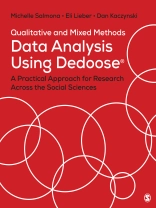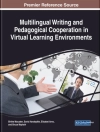Qualitative and Mixed Methods Data Analysis Using Dedoose®: A Practical Approach for Research Across the Social Sciences provides both new and experienced researchers with a guided introduction to dealing with the methodological complexity of mixed methods and qualitative inquiry using Dedoose® software. The authors use their depth of experience designing and updating Dedoose® as well as their published research to give the reader practical strategies for using Dedoose® from a wide range of research studies. Case study contributions by outside researchers provide readers with rich examples of how to use Dedoose® in practical, applied social science and health settings.
Spis treści
Foreword by Lyn Richards
Preface
Acknowledgments
Glossary: Dedoose Common Terms
About the Authors
PART I FOUNDATIONS OF MIXED METHODS RESEARCH
Chapter 1 Using Mixed Methods and Dedoose
1.1 About This Book
1.2 Mixed Methods and Mixed Paradigms
1.3 Using Cloud Technology to Support Mixed Methods Research
1.4 What Is Dedoose?
1.5 Dedoose: A Historical Journey
Chapter 2 Adopting Dedoose
2.1 Successful Adoption of Digital Tools
2.2 Framing the Purpose and Focus
2.3 Dedoose: Starting Your Project
2.4 Case Study: Using the Five-Level QDA® Method With Dedoose
Chapter 3 Bringing Data Into Dedoose
3.1 Gathering Mixed Data
3.2 Numbers as Data
3.3 Memos as Data
3.4 Case Study: Incorporating Mixed Analysis Into Your Study
3.5 Conclusion
Appendix: Types of Interview Data
PART II DATA INTERACTION AND ANALYSIS
Chapter 4 Teamwork Analysis Techniques
4.1 Team Management
4.2 Collaborative Interpretations
4.3 Coding in Teams
4.4 Bringing Procedures Into the Dedoose Environment
4.5 Team Conduct Rules
4.6 Case Study: Large-Scale, Multilanguage, Cross-Cultural Analysis With Dedoose
4.7 Conclusion
Chapter 5 Qualitative Analysis
5.1 Qualitative Analysis: Looking for Quality
5.2 Working With Codes
5.3 Case Study: Using Dedoose for a Multisite Study
5.4 Conclusion
Chapter 6 Designing Mixed Methods Analysis
6.1 Identifying Analysis Strategies
6.2 Using Descriptors
6.3 Topic Modeling
6.4 Case Study: Integrating Mixed Data in a Longitudinal Study
6.5 Conclusion
Chapter 7 Managing Complex Mixed Methods Analysis
7.1 Recognizing and Managing Complexity in Analysis
7.2 Data Complexity in Your Project
7.3 Using Visualization Tools for Analysis
7.4 Moving Through and Filtering Your Data
7.5 Case Study: Complex Yet Manageable—the Organizational Genius of Dedoose
7.6 Conclusion
Chapter 8 Working With Numbers in Dedoose: Statistics, Tabling, and Charting for Numbers, Weights, and Option List Field Data
8.1. Background/Introduction
8.2 Charts, Tables, and Plots for Individual Fields or Code Weights
8.3 Charts, Tables, Plots, and Analyses for Pairs of Fields/Code Weights
8.4 Summary
PART III REPORTING CREDIBLE RESULTS AND SHARING FINDINGS
Chapter 9 Reporting Your Findings
9.1 Reaching Your Audience
9.2 Mixed Methods Procedural Checklist
9.3 Case Study: Reporting to Multiple Audiences
Chapter 10 Sharing Data With a Larger Audience
10.1 Reaching a Larger Audience
10.2 Case Study: Sharing Qualitative Social Science Data
10.3 Changing Reporting Practices: Open Access
10.4 Final Word
Closing Remarks by Thomas S. Weisner
References
Index
O autorze
Professor Dan Kaczynski is Professor Emeritus at Central Michigan University and a senior research fellow at the IMMR. He is currently an adjunct professor supervising doctoral candidates at the University of Canberra, Australia. His research interests promote technological innovations in qualitative and mixed methods data analysis in the social sciences in the United States and Australia. Dan is a program evaluation consultant and has more than 20 years’ experience conducting state, national, and international evaluations. Leadership roles include K-12 and higher education administration and research center director with extensive experience as principal investigator of more than $35 million in grant awards. His work has been shared professionally with more than 250 professional presentations nationally and internationally. He has written more than 50 published research articles and eight books and book chapters. In addition, he has supervised over 100 doctoral dissertations and professional specialist theses.












